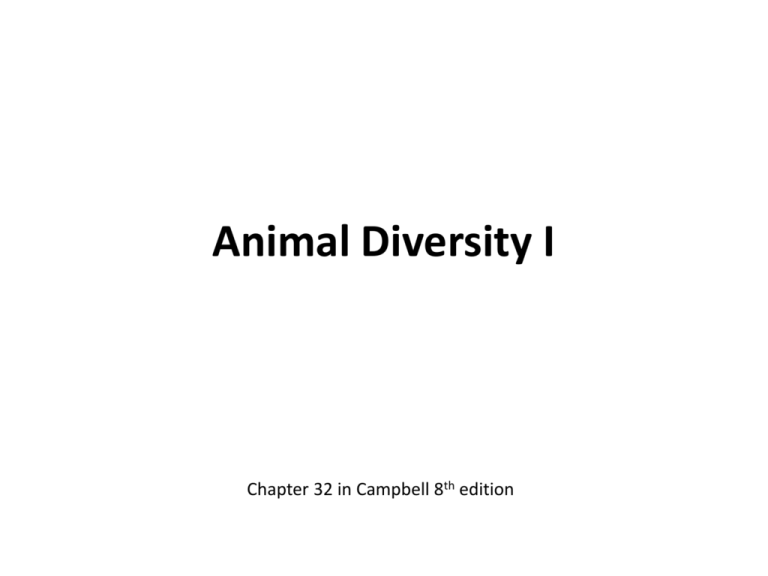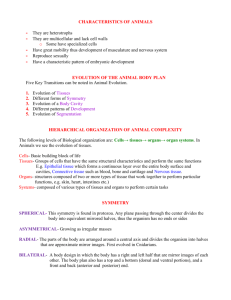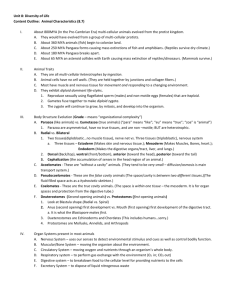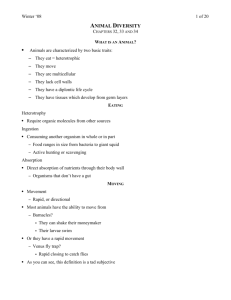Animal Diversity I
advertisement

Animal Diversity I Chapter 32 in Campbell 8th edition Objectives Understand evolutionary relationships Diversity of animal form and function *Just a note – a change in instructor can leads to a change in teaching style – this may facilitate a change in the way you need to study Phylogenetic Relationships Figure 32.10 Animal phylogeny based on sequencing of SSU-rRNA *good idea to be able to recreate this phylogenetic tree Major Concept PHYLA Phylogenetic Relationships to Form Metazoa - multicellular animals Parazoa – no true tissues or organs Eumetazoa – true tissues or show some tissue formation and organ systems Metazoa Break out the animals by 1. Absence or Presence of Tissues 2. Number of Tissues & Symmetry 3. Body Cavity & Tissue Phylogenetic Relationships to Form Break out the animals by 1. Absence or Presence of Tissues 2. Number of Tissues & Symmetry 3. Body Cavity & Tissue Asymmetrical –(no symmetry) no organized body plan Radial - body is arranged around a central point at all stages of life 2 Tissue Layers – diploblastic Bilateral - two identical mirror image halves 3 Tissue Layers – triploblastic Symmetry http://johnson.emcs.net/life/images/symmetry.bmp Phylogenetic Relationships to Form Break out the animals by 1. Absence or Presence of Tissues 2. Number of Tissues & Symmetry 3. Tissue Layers & Body Cavity within the tissues Body Cavities -Protostome-blastopore becomes mouth - Ecdysozoa-things that shed an exoskeleton through ecdysis-arthropods and nematodes - Lophotrochozoa-Larval stage called a trocophore larvae or have a feeding structure called a lophophore -Dueterostome-blastopore becomes anus-chordates and echinoderms Tissue Layers ectoderm - forms the outer layer mesoderm - middle layer endoderm - forms the interior layer Body Cavities Coelom – body cavity Acoelomate Pseudocoelomate Coelomate All are triploblastic. Why? What are they called? Evolutionary Relationships to Form Phyla Tissues Number of Tissues & Symmetry Body cavity origin Summary Animal Diversity – Memorize the different Phyla Identify the major characteristics of the different Phyla Use the major characteristics to place organisms into their Phyla Cells Tissues Organs Development from a zygote Body cavities Form & Function in relation to evolutionary advantage and ecological niche Lab Exercises The species used in each exercise are used for a purpose. Be able to explain why a particular species is used to represent that group. For example: sponges in Ex.1 are multi-cellular but don’t have organs or organized tissues. This puts them in the Parazoa and sets them apart from the Eumetazoa. Multi-cellular, no tissues or symmetry –Parazoa Exercise 1 – Phylum Porifera Number of Tissues & Symmetry – Exercise 2 – Phylum Cnidaria Body cavity types Acoelomates – Exercise 3 –Phylum Platyhelminthes Psuedocoelomates – Exercise 4 – Phylum Nematoda Coelomates – Exercise 5 – Phylum Mollusca –group Bivalvia Exercise 6 – Phylum Mollusca – group Cephlopoda Lab Exercise 1 - Grantia http://www.gc.maricopa.edu/biology/lsola/BI O182/labreview/porifera/porifera.htm http://students.cis.uab.edu/archived/mcljess/poriferaindex.html http://www.european-marine-life.org/02/photo-grantia-compressawb01.php Hydra magnipapillata, fresh water polyp http://www.geochembio.com/biology/organisms/ hydra/ Lab Exercise 2 http://universe-review.ca/R10-33-anatomy.htm Platyhelminthes- Flatworms http://sharon-taxonomy2009p3.wikispaces.com/Platyhelminthes hydrostatic skeleton diffusion Lab Exercise 3 Lab Exercise 4 http://www.savalli.us/BIO385/Diversity/13.Nematoda.html Lab Exercise 5 & 6 Dissections • The cold saltwater tank in lab contains examples from some of the groups studied in lab • DO NOT START CUTTING UP SAMPLES WILLY NILLY !!! • Clam and squid dissections - instruments, pans, gloves, and disposal container for dissection remains are on the side bench at the back of the room. • Please try to keep this area reasonably organized • Wash/rinse the instruments and pans after use • Make sure You dispose of dissection remains in the labeled container - NOT in the trash! Cool Links Nudibranchs link http://ngm.nationalgeographic.com/2008 /06/nudibranchs/doubilet-photography Veined octopus video-if you click on the box icon on the toolbar the video will switch to full screen mode http://news.nationalgeographic.com/new s/2009/12/091214-octopus-carriescoconuts-coconut-carrying.html Photograph courtesy Roger Steene Next Week ! ! Spring Break ! ! then Animal Diversity II









